

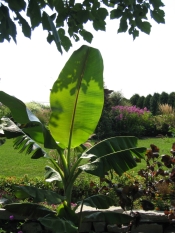 The Hahn Horticulture Garden is the sum of several smaller gardens and features, spread over nearly six acres. Most of the hardscape features, such as pergolas, arbors, decks, walls, and bridges, have been constructed by Robert McDuffie's Landscape Construction classes. Students, volunteers, and garden faculty and staff have created and planted the display beds. Scroll down for a sampling of our main features - many more await discovery on your next visit!
The Hahn Horticulture Garden is the sum of several smaller gardens and features, spread over nearly six acres. Most of the hardscape features, such as pergolas, arbors, decks, walls, and bridges, have been constructed by Robert McDuffie's Landscape Construction classes. Students, volunteers, and garden faculty and staff have created and planted the display beds. Scroll down for a sampling of our main features - many more await discovery on your next visit!
The garden features hundreds of species of woody and herbaceous plants from around the world, showcased in various features: a multi-acre shade garden, “hot” perennial border, spectrum mixed border, xeriphytic garden, two water features including the Jane Andrews Memorial Stream Garden, Pavilion tent lawn and folly, meadow garden, and the Peggy Lee Hahn Garden Pavilion (special event facility and staff offices).
 Designed by Hill Studios, completed in 2006, the Peggy Lee Hahn Garden Pavilion multi-purpose facility graces the hill in the "new" part of the garden. The front beds feature outstanding landscape plants, including the hottest new annuals and tropicals. The southwest-facing patio and surrounding landscape was dedicated in 2008 as the Jocelyne Couture-Nowak Memorial Terrace Garden in honor of our department head's wife, lost in the April 16, 2007 tragedy.
Designed by Hill Studios, completed in 2006, the Peggy Lee Hahn Garden Pavilion multi-purpose facility graces the hill in the "new" part of the garden. The front beds feature outstanding landscape plants, including the hottest new annuals and tropicals. The southwest-facing patio and surrounding landscape was dedicated in 2008 as the Jocelyne Couture-Nowak Memorial Terrace Garden in honor of our department head's wife, lost in the April 16, 2007 tragedy.
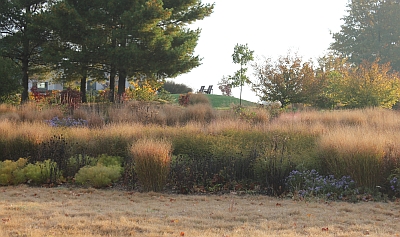 Dedicated in June 2008, the Hahn Meadow Garden is our newest garden feature, situated between Duck Pond Drive and the Garden Pavilion, and includes the Hahn Amphitheater and Peggy's Meadow. The amphitheater is constructed of Hokie Stone and provides hillside outdoor seating for up to 75 people. The meadow property covers two- thirds of an acre and features native perennials, grasses, trees, and shrubs planted in the sweeping "New American Garden" style. A "swale"dry stream was completed in 2013.
Dedicated in June 2008, the Hahn Meadow Garden is our newest garden feature, situated between Duck Pond Drive and the Garden Pavilion, and includes the Hahn Amphitheater and Peggy's Meadow. The amphitheater is constructed of Hokie Stone and provides hillside outdoor seating for up to 75 people. The meadow property covers two- thirds of an acre and features native perennials, grasses, trees, and shrubs planted in the sweeping "New American Garden" style. A "swale"dry stream was completed in 2013.
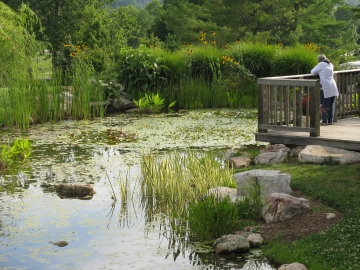 The Jane Andrews Memorial Stream Garden is an extraordinary 200' long water garden, built in 2002 under the guidance of Dr. Robert Wright of the Department of Horticulture. A Hokie Stone bridge provides a view of the 10' water fall and pool below. The stream widens to a large pond with an overlooking deck. Goldfish and large koi swim among more than twenty species of emergent (bog) and aquatic plants.
The Jane Andrews Memorial Stream Garden is an extraordinary 200' long water garden, built in 2002 under the guidance of Dr. Robert Wright of the Department of Horticulture. A Hokie Stone bridge provides a view of the 10' water fall and pool below. The stream widens to a large pond with an overlooking deck. Goldfish and large koi swim among more than twenty species of emergent (bog) and aquatic plants.
 Ten trident maples (Acer buergeranum) form the Trident Maple Allee - a towering arch of branches that welcomes visitors to our shade gardens. The trees were mere 6' tall whips when planted by Robert Lyons and students back in the early days of the garden. Here also resides our "garden sprite" - a sandstone rendition of Frank Lloyd Wright's "Maid in the Mud", donated by Warren and Margie Kark. Paved and grass paths wind through mature shade gardens taking our visitors past hundreds of trees, shrubs, and perennials from all over the world. Benches throughout create an inviting place to linger, eat lunch, or read a book, all within earshot of a small, burbling water garden.
Ten trident maples (Acer buergeranum) form the Trident Maple Allee - a towering arch of branches that welcomes visitors to our shade gardens. The trees were mere 6' tall whips when planted by Robert Lyons and students back in the early days of the garden. Here also resides our "garden sprite" - a sandstone rendition of Frank Lloyd Wright's "Maid in the Mud", donated by Warren and Margie Kark. Paved and grass paths wind through mature shade gardens taking our visitors past hundreds of trees, shrubs, and perennials from all over the world. Benches throughout create an inviting place to linger, eat lunch, or read a book, all within earshot of a small, burbling water garden.
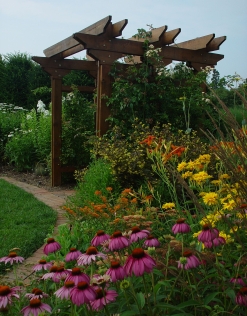 A rainbow of shrubs and perennials comprises the circular Spectrum Border in the front of the garden. Three trellises, graced with climbing roses, help define this small garden.The intent of the space was to fit as many species and cultivars of perennials as possible, organizing them by color. Originally constructed in 2003, the plantings were renovated in 2018-19 to re-define the color spectrum.
A rainbow of shrubs and perennials comprises the circular Spectrum Border in the front of the garden. Three trellises, graced with climbing roses, help define this small garden.The intent of the space was to fit as many species and cultivars of perennials as possible, organizing them by color. Originally constructed in 2003, the plantings were renovated in 2018-19 to re-define the color spectrum.
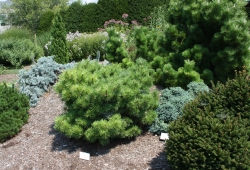 The Conifer Display features delightful dwarf evergreen conifers aswell as full-sized specimens.Originally planted in 2001, it serves as a great reference forgrowth rates of various species and cultivars suitable for the home landscape. The bed is anchored by our most iconic tree - the majestic Chamaecyparis nootkatensis ‘Glauca Pendula’ (Nootka false cypress or Alaska cedar). This display is continually updated and expanded.
The Conifer Display features delightful dwarf evergreen conifers aswell as full-sized specimens.Originally planted in 2001, it serves as a great reference forgrowth rates of various species and cultivars suitable for the home landscape. The bed is anchored by our most iconic tree - the majestic Chamaecyparis nootkatensis ‘Glauca Pendula’ (Nootka false cypress or Alaska cedar). This display is continually updated and expanded.
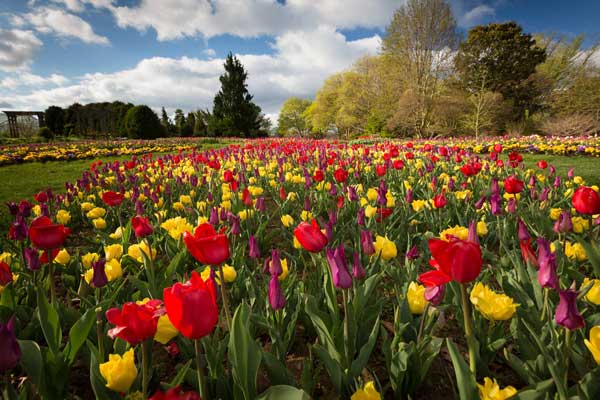 The Entrance Beds face Washington Street and draw passers-by into the garden. Masses of tulips brighten the scene each spring, then the warm season features a new and different palette of plants each year - mostly annuals and tropicals. The Entrance Annual Beds feature a burst of color to create an eye-catching display.
The Entrance Beds face Washington Street and draw passers-by into the garden. Masses of tulips brighten the scene each spring, then the warm season features a new and different palette of plants each year - mostly annuals and tropicals. The Entrance Annual Beds feature a burst of color to create an eye-catching display.
The Utility Line Arboretum displays trees (and a few large shrubs) that have a proven track record of performance in urban environments and compatibility with overhead utility lines. Developed by the Virginia Tech Urban Forestry program. More information can be found on their website: https://www.plantsmap.com/organizations/452/collections/30287